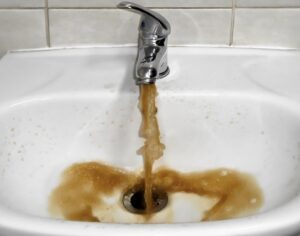Bust out the rust!
Iron is a chemical element that is classified as a metal. It is also an essential mineral found in our bodies. Iron is common in the Earth’s crust. As water moves through soil layers it dissolves iron causing it to seep into groundwater. Iron pipes also may be a source of iron in water. Levels of iron found in drinking water are considered harmless but can be a nuisance. Even the smallest amount of iron can stain your laundry and fixtures and give your water a bitter or metallic taste.
Iron can be in soluble or oxidized form. Water with soluble iron looks clear when it comes out of the faucet but has red rust in it when left standing. Oxidized iron looks red from the tap. Iron is considered a secondary water contaminant. Continue reading about Iron & Well Water.
The not so innocent one…
Manganese is an abundant metal on Earth. It can be found in air, consumer products, food, and water. Manganese makes its way into groundwater and surface water from natural sources or from activities like mining and industrial discharges. Manganese is used in many industries, with the majority of manganese used as an alloying element in steel.
In water, manganese can look yellow, brown, or black and is often found together with iron and a low pH. Manganese can cause water to taste unpleasant and stain fixtures and water appliances throughout your home. Manganese is essential for human health. However, studies show too much manganese may cause neurological effects in children. Read more about testing and treating Manganese.


